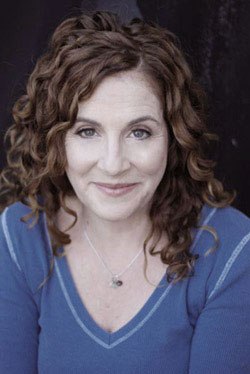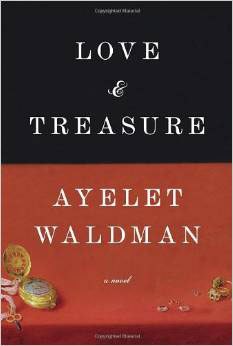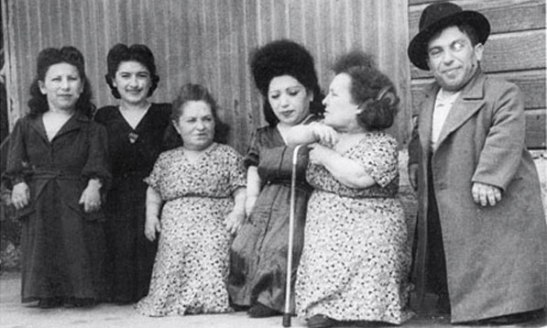Lost Treasure: An Interview with Ayelet Waldman
When Ayelet Waldman set out to write her new novel, Love and Treasure, it was with the vague idea that she wanted to write about the Holocaust and art. How, though, to write about the Holocaust? It seemed hard to say anything new, and particularly hard to set a scene in a concentration camp, she says, “without seeming exploitative.”
An unlikely opportunity came up when her friend, Eleni Tsakopoulos Kounalakis, was appointed American ambassador to Hungary. Eager to visit her friend, Waldman Googled “Hungary, Holocaust, Art” on a whim and suddenly found herself reading the fascinating story of the Hungarian Gold Train.
Piled with valuables seized from Hungary’s Jews, the Gold Train was in transit from Budapest to Berlin when the war ended. The American army took over the train in Austria, but had no idea what to do with its jewelry, furs, linens and art. Over half of Hungary’s Jews had perished; many others were in Displaced Persons camps. Restitution needed to be made, but to whom and how?
Around these facts, Waldman weaves an intricate story that plays out over several generations. Connecting each of the parts is a talismanic piece of jewelry, a peacock-adorned locket in the colors of the suffragist movement, with a mysterious photograph hidden inside.
The characters are vivid and memorable, from Jack, a Jewish American soldier assigned to guard the train’s contents, to Natalie, Jack’s bereaved-but-determined granddaughter. There is also a dashing Syrian dealer who specializes in recovering stolen art, and–in the novel’s most whimsical touch–a lively feminist dwarf.
Waldman keeps all these balls in the air with admirable grace, integrating her research seamlessly. Photographs formed an important part of the research, from propaganda images of Jewish gold to pictures taken in Displaced Persons camps. One plot development hinges on an image inspired by the archive of Rozsa Schwimmer, a turn-of-the-century Hungarian feminist.
As anyone who read her 2009 essay collection Bad Mother will know, Waldman is not a writer who pulls punches. In Love and Treasure she delves into some difficult matters—including, in addition to American looting of the Gold Train, the lack of solidarity between Jews in the wake of the Holocaust.
Last week, The Literate Lens caught up with Waldman while she was on tour for Jewish Book Month.
How did you find out about the Hungarian gold train?
It was this crazy Google thing. I knew I wanted to visit my friend Eleni in Hungary, and that I wanted to write about the Holocaust and art, but wanted to take an approach that didn’t seem typical. So I Googled “Hungary, Holocaust, art.” I was just noodling around, and suddenly there it was, this amazing story about the Hungarian gold train.
It’s an amazing story. Why do you think so little is known about it?
I think, basically, that the Iron Curtain silenced a lot of voices. None of the countries behind the curtain went through a period of reflection the way the Germans did, and the Austrians to a certain extent. Because of that, the Hungarians didn’t confront any of their culpability—and the story of the gold train is a story of culpability. It’s true that Hungary was invaded by Germany in 1944, but before that the Hungarians had been eager allies of the Nazis, and after the invasion they were willing collaborators.
You refer, in the book, to propaganda photos the Germans made showing the wealth of the Jews. What did those look like?
I have this one amazing photo that shows a heap of gold plate–ingots, statues, jewelry. This photo was used to send a message about the fantastic wealth of the Jews. It’s true there were wealthy Jews, and many middle class Jews, but the Jews of Hungary and Germany had always been willing to donate money to the causes of their countries. During World War One, German Jews eagerly gave, including even a synagogue that donated its gilded ceiling and metal roof to the German government for the war effort. The propaganda just fed into a well-worn trope: the Jews are stealing your money.
There are other important photographs in the book. The plot actually revolves around a photograph hidden in a locket, an image of two women at a suffragists’ conference. What led you to include that?
I was inspired by a photo archive that the Hungarian feminist Rozsa Schwimmer left: it’s in the New York Public Library, and it’s all online. It’s the most astonishing collection of photographs. We’re used to seeing photographs of that time period where people have a posed formally, but so many of these images from the 1913 suffragists’ conference in Budapest show people with full-hearted grins and smiles, bursting with joy. They just seemed so alive and contemporary.
One of the women in the locket’s photograph, a dwarf named Gizella Weisz, appears as a character in the third part of the novel. She was inspired in part by members of the Ovitz family, vaudevillian dwarves who were experimented on by Josef Mengele at Auschwitz. How did she make her way into the book?
My husband Michael was doing a residency at the MacDowell artists colony, where he was talking to a visual artist who’d read a book about the Ovitz family. I’d been saying to him, there’s something missing from this novel, some specific element, some fairy dust to elevate the story, and he came home saying, I know what you’re missing: a family of vaudevillian dwarves! Hard to believe, I know, but I hadn’t thought of that. And indeed it was the missing piece.
Natalie, one of the protagonists of the first part of the novel, admits she grew up obsessed with the Holocaust, and by one photograph in particular, of a man who died while crawling under the wall of a concentration camp. Is that a real photograph, and if so, were you obsessed with it?
It is and I was. In Hebrew school they’d show us photographs like that all the time. That one sticks in my memory the most because of the incredible will to escape that it portrays. The man had tried so hard to burrow under the wall and escape, but made it only as far as freeing his face. I’ve never been able to get that out of my mind.
How do you feel about showing children those kinds of photographs? There’s a difficult balance between following the edict of “Never Again” and possibly traumatizing a child for life!
Absolutely, it’s very fraught. I chose not to send my kids to a Hebrew school that showed them all those photographs, but sometimes I wonder if they missed out on something by not experiencing that trauma. Recently I gave a talk at the Harvard Law School, and I was asked to give a “trigger warning” that there were disturbing photographs in my presentation. I think we sometimes go to absurd lengths to avoid being made uncomfortable. Art should trigger you. It should make you uncomfortable! If you don’t feel the trauma in my book, then I haven’t done my job.
At the same time, it’s arguable that we’ve reached a point of Holocaust fatigue, with so many books and movies about it. Did that worry you, going into this novel?
I certainly thought about it. In Israel, they have a term for all the art, films and books about the Holocaust—they call it ‘the Shoah show.’ But I do think it’s incredibly important to keep telling stories. For me, I felt I couldn’t write a scene in the camps without it seeming exploitative in some way. But even that’s not impossible. Martin Amis’s new book The Zone of Interest is set entirely in the camps, and it’s an astonishing novel. He managed to say and show something new.
For me, one of the most interesting parts of the novel was when the Holocaust survivors were smuggled out of Europe and onto a boat to Palestine. You deal with the uncomfortable fact that the Palestinian Jews looked down on these people and wanted to use them get media attention. It’s not exactly the Leon Uris ‘Exodus’ myth that many of us grew up with. How did you research that, and was it uncomfortable to expose?
I knew it was controversial, and that I had to have all my ducks in a row if I was going to write about it. It had to all be accurate and unimpeachable. So the things the young Zionists say about the survivors in my novel are all virtual quotes from a volume of David Ben Gurion’s letters and journals, and other contemporary journals. It was all true. In a way, the thing the Zionists wanted more than anything was a photo of the British fleet firing on a boatload of survivors. At that time, Britain had closed Palestine to immigrants, and they knew it would only be opened again if there was public sympathy and pressure.
You’re in the middle of a crazy tour schedule for Jewish Book Month, criss-crossing the country. How has it been to take the novel to synagogues and Jewish community groups?
It’s been amazing. At one event in Austin, a group brought in family heirlooms of their own and told stories about them. In Harrisburg, Pennsylvania, they put on a huge Hungarian dinner. In Toronto there was an audience of hundreds, and many were Holocaust survivors. It’s the last possible moment for that, and it felt pretty special.
One last photography question. In your book trailer, there’s a photograph of a woman in what looks like a displaced persons camp after the war. She looks just exactly as I imagined Ilona, the feisty redhead protagonist of the first part of the book. At what point in the process did you find that photo?
We found it when we were making the book trailer. We had to find images that were in the public domain, and we combed through a lot of images on the Internet—thank goodness for the Internet! When we saw that photograph, it was perfect. To me too, she looks exactly right.
————————————————————————————————
Visit Ayelet Waldman’s website here.
Buy Love and Treasure.
2 comments on “Lost Treasure: An Interview with Ayelet Waldman”
Leave a Reply
Connecting to %s











How fortuitous that the author came across the history of the Hungarian Gold Train. Sounds like a fascinating read.
This is an astonishing book and one I compare to The Signature of All Things, by Elizabeth Gilbert, as a great work of scholarship and artistry.. Thank you Ayelet!